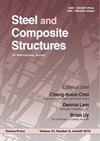钢结构和组合结构
IF 3.9
3区 工程技术
Q1 CONSTRUCTION & BUILDING TECHNOLOGY
引用次数: 0
摘要
基于构件的方法被广泛应用于钢结构节点初始刚度分析。本文以端板连接为重点,建立了确定受拉方形或矩形空心截面(SHS/RHS)柱面刚度的解析构件模型。利用有限元模型数据库的数值结果,通过回归分析,推导出了SHS/RHS柱端面弯曲刚度的计算公式。由于螺栓孔的存在降低了柱表面的抗弯刚度,因此通过数值分析,采用了一种新的基于板弹簧的模型来计算这种影响。将所建立的构件模型首次应用于试验确定的SHS柱端面抗弯刚度的预测。此外,将该模型与其他有效构件(如受拉螺栓)结合到基于构件的方法中,确定连接SHS柱的t形短节连接的抗拉刚度和节点的初始旋转刚度。通过对模型预测、试验数据和数值结果的比较,验证了该模型在计算SHS柱端面抗弯刚度方面具有满意的精度。本文章由计算机程序翻译,如有差异,请以英文原文为准。
Steel and Composite Structures
The component-based method is widely used to analyze the initial stiffness of joint in steel structures. In this study, an analytical component model for determining the column face stiffness of square or rectangular hollow section (SHS/RHS) subjected to tension was established, focusing on endplate connections. Equations for calculating the stiffness of the SHS/RHS column face in bending were derived through regression analysis using numerical results obtained from a finite element model database. Because the presence of bolt holes decreased the bending stiffness of the column face, this effect was calculated using a novel plate-spring-based model through numerical analysis. The developed component model was first applied to predict the bending stiffness of the SHS column face determined through tests. Furthermore, this model was incorporated into the component-based method with other effective components, e.g., bolts under tension, to determine the tensile stiffness of the T-stub connections, which connects the SHS column, and the initial rotational stiffness of the joints. A comparison between the model predictions, test data, and numerical results confirms that the proposed model shows satisfactory accuracy in evaluating the bending stiffness of SHS column faces.
求助全文
通过发布文献求助,成功后即可免费获取论文全文。
去求助
来源期刊

Steel and Composite Structures
工程技术-材料科学:复合
CiteScore
8.50
自引率
19.60%
发文量
0
审稿时长
7.5 months
期刊介绍:
Steel & Composite Structures, An International Journal, provides and excellent publication channel which reports the up-to-date research developments in the steel structures and steel-concrete composite structures, and FRP plated structures from the international steel community. The research results reported in this journal address all the aspects of theoretical and experimental research, including Buckling/Stability, Fatigue/Fracture, Fire Performance, Connections, Frames/Bridges, Plates/Shells, Composite Structural Components, Hybrid Structures, Fabrication/Maintenance, Design Codes, Dynamics/Vibrations, Nonferrous Metal Structures, Non-metalic plates, Analytical Methods.
The Journal specially wishes to bridge the gap between the theoretical developments and practical applications for the benefits of both academic researchers and practicing engineers. In this light, contributions from the practicing engineers are especially welcome.
 求助内容:
求助内容: 应助结果提醒方式:
应助结果提醒方式:


